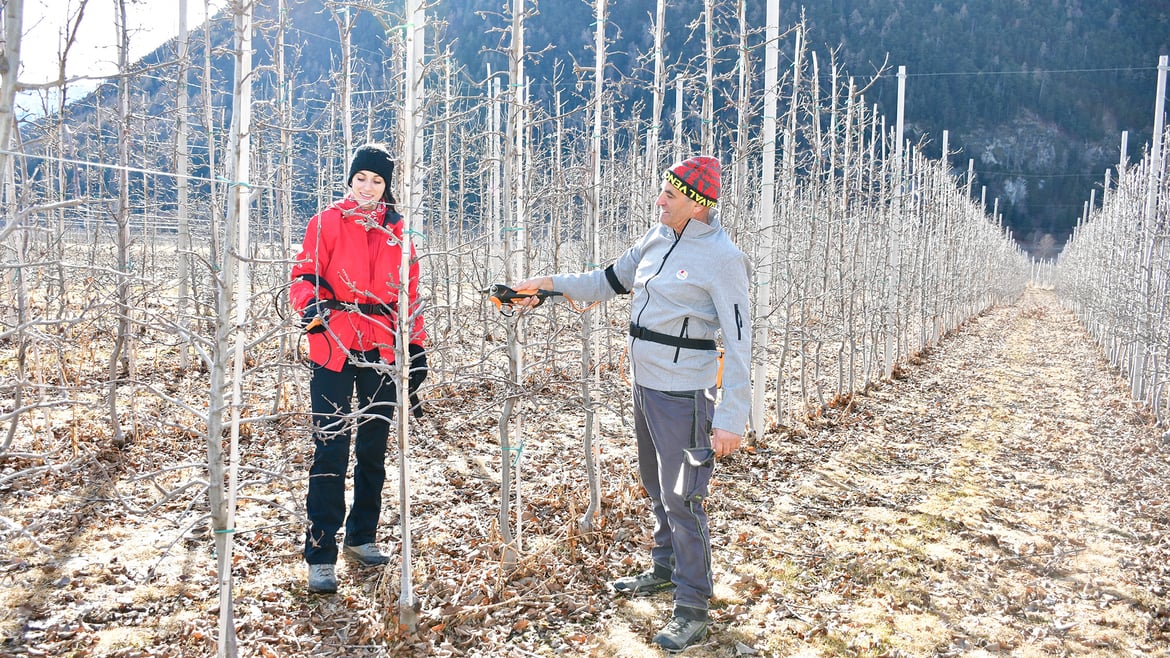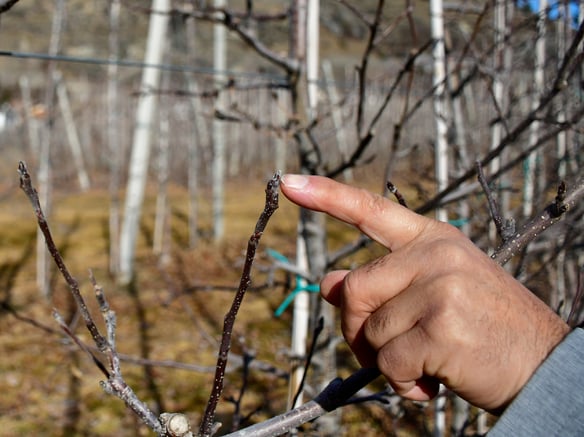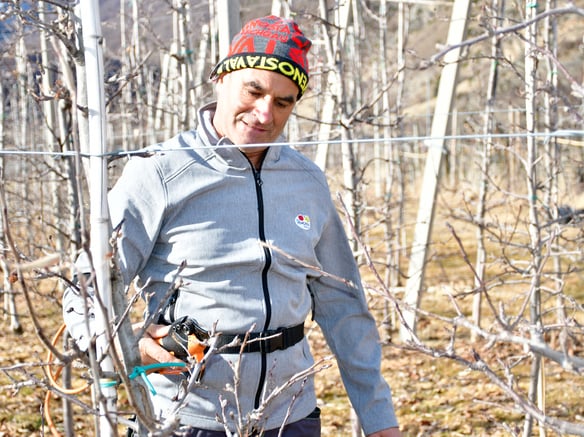It is the end of February and Ernst from the "Stampflhof" farm in Cengles is standing - equipped with modern pruning shears - between the apple tree rows of his Royal Gala. Today's apple orchard is located in Laudes in the Upper Val Venosta valley at a proud 984 m above sea level. Here too, very close to the border with Switzerland, magnificent Royal Gala apples will be ripe in late summer.
"Magnificent yes, but only if WE do everything in the right way now when pruning the trees!" emphasises Ernst, pointing with his shears to his daughter Franziska, who is swinging her shears from branch to branch with the same manual dexterity, blindly trusting her sensitivity for the trees‘ needs. Even when Franzi was a child, her father regularly took her to the apple orchard. It usually takes some years of experience before one has absorbed the art of pruning in automated, intuitive and relatively swift movements. Franzi also had to grow into it, so to speak. It's a bit like learning a new language, which is easier at a young age. At the very beginning, Franzi also stood reverently in front of each branch and considered, often for minutes, whether it had to be cut off or not. A not trivial decision, especially since the quantity and above all the quality of the future apples depend on the right pruning. This is also how a Val Venosta farmer's child learns to deal with responsibility.
"The purpose of pruning in winter is not to make the tree look beautiful, but then the apples in autumn! We don't cultivate bonsai trees to look at, but raise fruit trees whose fruits delight our customers. If we prune the trees correctly, they stay vital and regularly produce quite a lot of good, healthy fruit," Franzi sums it up.
What used to take too long to think about when she was inexperienced, now works quickly and instinctively, so that she and her father Ernst can manage the approximately 1,300 trees in this orchard in one and a half working days. Ernst's son-in-law Christoph and "best buddy" Isidor often help out diligently. Because in lively company, pruning is easier even in sub-zero temperatures and one is somewhat distracted from the icy Val Venosta wind that blows across the Malles Heath in February and does not feel like a warm foehn wind at all. There are some important basic rules to follow when pruning trees, but as already said, it is better to implement them instinctively than to have to think about them for too long. Thus shears gently move following the rhythm of the wind, which also makes the leaves rustle on the ground.
"In any case, branches that grow too steeply upwards and do not produce flower buds but only leaf buds should be cut off. Also branches that compete with each other as well as those that grow inwards or even cross each other. It is very important to take care of the crown and generally to grow a conical, Christmas tree-like appearance of the tree," explains Ernst, who learned his skills in the art of pruning from a farmer friend.
Keeping the tree crown light and loose and allowing the Val Venosta wind to flow through it brings many advantages. Much more sunlight then shines on the leaves, which through their photosynthesis can produce enough energy for ripe and sweet fruit. In addition, the wind dries the leaves better in a light treetop and a dry crown is then less susceptible to fungal diseases. Even harvesting in late summer or autumn is easier with a well-grown crown.
"The branches that will grow the best apples, those have to stay on. These are those branches that do not branch off steeply, but relatively flat. The best apples grow from two-year-old shoots." is how Franzi, the trained secretary, sums it up. It all sounds quite simple, but only for experienced pruners like Franzi and Ernst. As a layman, you probably find it difficult to distinguish in a matter of seconds a branch with only leaf buds from another that has both flower and leaf buds. When the farmers here play barber to the tree, they are striving to achieve the necessary harmony between foliage and flowers and the resulting fruit.
It is only in the months to come that even the most experienced Val Venosta farmer realizes how important it was to promote this harmony. "Only in autumn do we see the effect of pruning. The variety also plays a big role. A Golden Delicious apple tree is much more vigorous than a Royal Gala. You have to take that into account when pruning. Essentially, it is a matter of choosing those branch shoots that can provide a stable and, if possible, shade-free bearing surface for the growing apples. By cutting away the unsuitable branches, you channel the tree's energy into the right branches," Ernst explains with the confident joy of a man who knows what he is talking about.
Even in the highest apple-growing region in Europe, where the fruit ripens more slowly than elsewhere, a lot of time has to be devoted to the detailed art of tree pruning. For here, too, apple trees like to grow hot-bloodedly into the sky if they are not lovingly accompanied in their growth towards the mountain sun. The right balance between leaf growth and blossom growth is influenced by the Val Venosta farmer precisely in these days in February, when the alpine soils are still mostly frozen, but in the warmer times of day they also let their ice melt and the apple orchard then feels very damp, like after a fresh rainfall. At this time the apple trees do not grow a millimetre and their old leaves have long since fallen off. But the Val Venosta mountain sun is already announcing its 300 days of sunshine a year and notifies the Val Venosta farmers in good time so that they can trim the crowns and side branches of their trees properly. After all, it wants to reach the upcoming leaves, blossoms and fruits without many obstacles. In order to guarantee Franzi and Ernst rich nutrients for the formation of splendid apples.
Therefore, this time of awakening must best begin with a skilful Val Venosta silhouette cut and good pruning shears.






